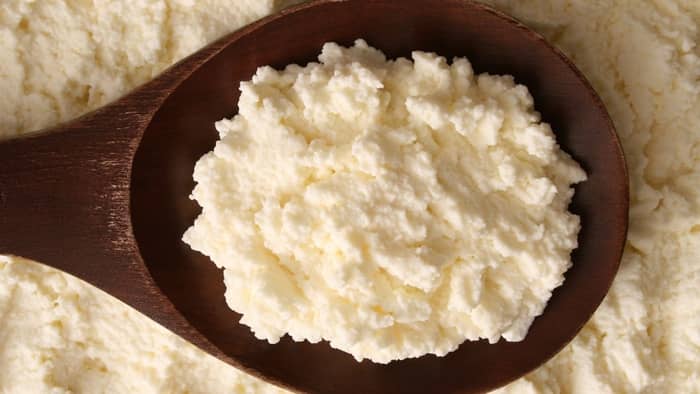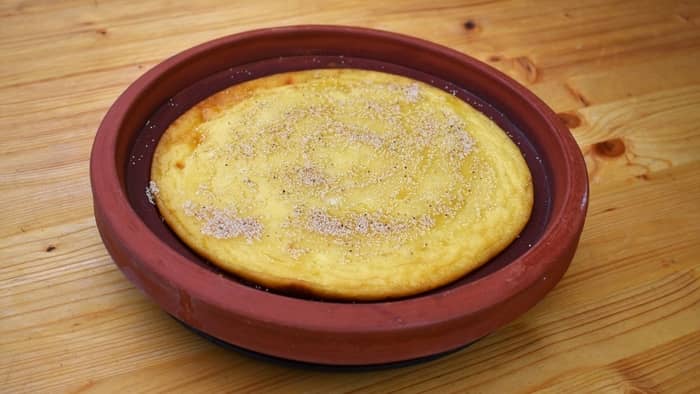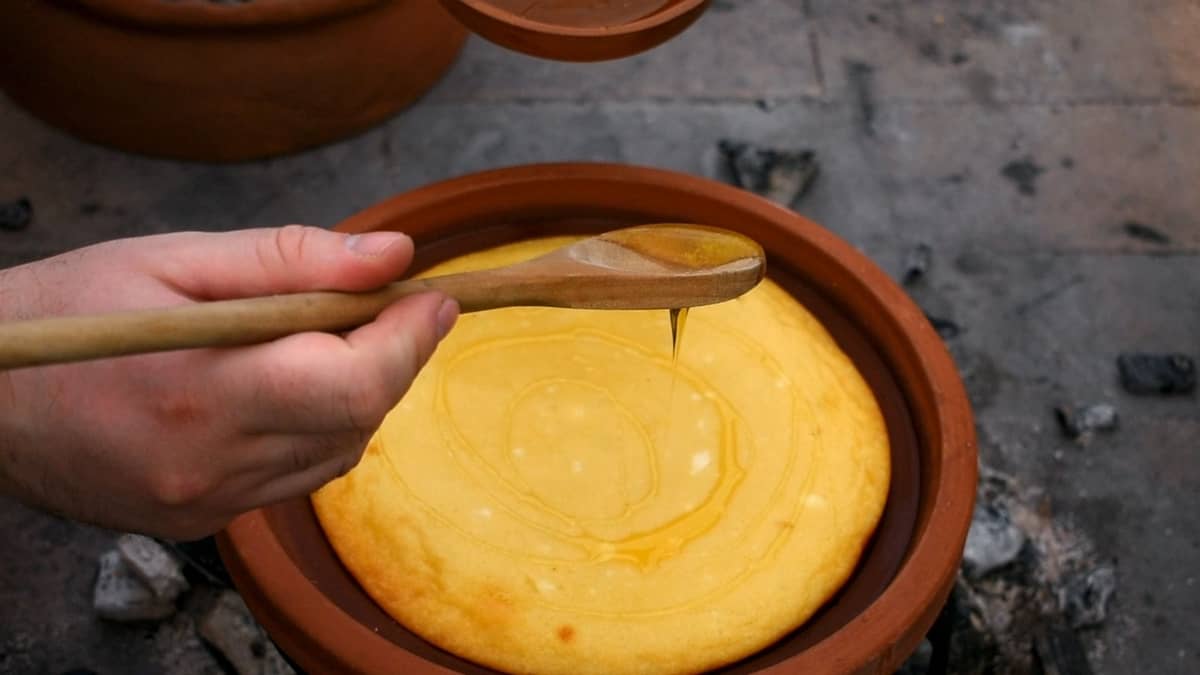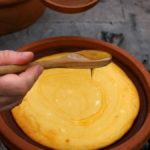By Lindy Van Schalkwyk, last updated on November 2, 2024
This incredibly quick and easy ancient roman cheesecake will stack up against any modern recipe. It’s simple yet packed full of flavor!
The absolutely had to share this recipe with you today. You know we are obsessed with cheesecakes, so it is only natural that we have included an ancient cheesecake recipe like this. It only needs a few ingredients and is surprisingly well balanced in flavor. And, at least in our opinion, much less fussy compared to modern cheesecakes today!
What Is An Ancient Roman Cheesecake?
This ancient roman cheesecake, also known as Savillum, is a type of soft dessert that is often eaten as-is with a spoon. It is actually very different from modern cheesecakes today, but definitely worth a try!
This is one of those incredibly easy ancient roman dessert recipes that has made its way into modern homes. These cheesecakes are made from a combination of flour, eggs, and ricotta cheese.
Ricotta is a fresh soft cheese made from animal whey. Whey is the leftover product from milk during the cheese-making process. Once the milk has curdled and been strained, the whey is often used to make other types of cheeses.
Roman cheesecake is also often flavored with bay leaves and honey. This creates a beautiful balance of salty and sweet flavors. And, what makes it even more unique compared to “regular” cheesecake, is that it can be served hot or cold.

Savillum Cheesecake Vs Modern Cheesecake
While there are many similarities between Savillum cheesecake and modern cheesecakes (like a New York-style cheesecake), there are also a few key differences.
The first is in the recipe itself. Ancient roman cheesecake isn’t nearly as sweet as compared to modern recipes you find today.
Then, while modern cheesecakes are also frequently baked, this one doesn’t have to be cooled (to set) at all.
Another big difference is that savillum cheesecakes can be served warm or cold. Most cheesecakes today are chilled first for a couple of hours and served cold or at room temperature.
And finally, these ancient cheesecakes aren’t decorated in any way. They can be served with some toasted white sesame seeds or a drizzle of honey. They don’t have any glazes, toppings, or frostings.
What You Will Need For This Savillum Recipe
Ingredients
- 16 bay leaves
- 6 eggs, room temperature
- 16 ounces ricotta cheese
- 1 cup honey
- Zest of a lemon
- 1 teaspoon lemon juice
- 1 cup cake flour, sifted
Equipment
- Springform cake pans
- Small over-proof bowl
- Large mixing bowl
- Electric hand or stand mixer
Step by Step Instructions To Make Roman Cheesecake
Step 1: Preheat the Oven and Prepare the Equipment
You can preheat your oven to 425°F (220°C). Arrange the bay leaves over the bottoms of your springform cake pans.
Then, place a small bowl of water inside the oven. Make sure the bowl is over-proof. This will help create some steam while the cheesecake is baking.
Step 2: Make the Batter
In a large mixing bowl, start beating the eggs at a medium speed. Once the eggs are a uniform consistency, add in the softened ricotta cheese along with the honey, lemon zest, and lemon juice.
Once the ingredients have been well combined, sprinkle in the flour while slowly stirring the mixture. You can set the mixer to a slower speed or use a large spoon to mix in the flour.
Step 3: Bake the Ancient Roman Cheesecake Batter
Gently pour the cheesecake batter into the springform cake pans. Be careful not to move the bay leaves as you are pouring the batter.
Bake the cheesecake for roughly 35-40 minutes on the middle rack of the oven. The cheesecake is done when it no longer “jiggles” and when the top has a nice golden brown color.
Step 4: Serve the Cheesecake
Once it has been fully caked, run a sharp thin knife around the edges of the cake pan to separate the cheesecake from the sides. Then, remove the springform pan.
Invert the baked cheesecake onto a serving plate and allow it to stand for about 30 minutes. Then, you can either serve it while it is still warm or allow it to chill inside of the fridge.

Tips and Tricks for this Ancient Roman Cheesecake Recipe
- For the springform cake tins, you can lightly coat them with olive oil if you’d like, but we don’t feel that it is necessary. Most spring-form cake pans are non-stick.
- The reason that we add a small bowl of water inside of the oven when the cheesecake is baking, is because it helps create steam. While this sin;t necessarily a traditional method used to bake cheesecake, it does help soften the texture of the baked cheesecake. It also helps prevent the top from over-baking too quickly.
- Many people also like kneading the mixture. This is a method the Ancient Romans used and can still be used today. It is however very messy, which is why we suggest using a stand mixer.
- Instead of ricotta cheese, you can also use cottage cheese, soft goat’s cheese, or even cream cheese or Mascarpone. These options will allow you to make different flavored-savillum recipes. The ancient texts from which this dish came doesn’t mention exactly which cheese was used, but we know that Romans made a variety of goats, sheep, and cows’ soft cheeses.
- This roman cheesecake has to be baked. It contains eggs that aren’t always safe to consume raw, let alone half-cooked. Make sure you bake the cheesecake for long enough.
- This cheesecake is very different from the regular cheesecakes we know today. They are often served without any garnishes or glazes. You can finish off the cheesecake with a honey drizzle or some white sesame seeds. We like toasting our sesame seeds to add a nutty flavor. The sesame seeds also add some texture to the otherwise smooth and creamy cheesecake.
Servings and Preparation Time
| Prep time | Cooking time | Servings |
| 10 minutes | 40 minutes | 10-12 |
Final Thoughts
Who knew that such an ancient dessert could still have a place in modern kitchens. But, this cheesecake is a winner! It is incredibly easy to make, only requires a few simple ingredients, and is surprisingly versatile. If you know of anyone that would love this recipe, share it and let us know what you think!
Savillum Roman Cheesecake Recipe
Equipment
- Springform cake pans
- Small over-proof bowl
- Large mixing bowl
- Electric hand or stand mixer
Ingredients
- 16 bay leaves
- 6 eggs room temperature
- 16 ounces ricotta cheese
- 1 cup honey
- Zest of a lemon
- 1 teaspoon lemon juice
- 1 cup cake flour sifted
Instructions
- You can preheat your oven to 425°F (220°C). Arrange the bay leaves over the bottoms of your springform cake pans.
- Then, place a small bowl of water inside the oven. Make sure the bowl is over-proof. This will help create some steam while the cheesecake is baking.
- In a large mixing bowl, start beating the eggs at a medium speed. Once the eggs are a uniform consistency, add in the softened ricotta cheese along with the honey, lemon zest, and lemon juice.
- Once the ingredients have been well combined, sprinkle in the flour while slowly stirring the mixture. You can set the mixer to a slower speed or use a large spoon to mix in the flour.
- Gently pour the cheesecake batter into the springform cake pans. Be careful not to move the bay leaves as you are pouring the batter.
- Bake the cheesecake for roughly 35-40 minutes on the middle rack of the oven. The cheesecake is done when it no longer "jiggles" and when the top has a nice golden brown color.
- Once it has been fully caked, run a sharp thin knife around the edges of the cake pan to separate the cheesecake from the sides. Then, remove the springform pan.
- Invert the baked cheesecake onto a serving plate and allow it to stand for about 30 minutes. Then, you can either serve it while it is still warm or allow it to chill inside of the fridge.
Notes
Tips and Tricks for this Ancient Roman Cheesecake Recipe
For the springform cake tins, you can lightly coat them with olive oil if you'd like, but we don't feel that it is necessary. Most spring-form cake pans are non-stick.The reason that we add a small bowl of water inside of the oven when the cheesecake is baking, is because it helps create steam. While this sin;t necessarily a traditional method used to bake cheesecake, it does help soften the texture of the baked cheesecake. It also helps prevent the top from over-baking too quickly.
Many people also like kneading the mixture. This is a method the Ancient Romans used and can still be used today. It is however very messy, which is why we suggest using a stand mixer.

Lindy Van Schalkwyk is a culinary specialist with a background in Advanced Cooking, Advanced Pâtisserie, Media Communications and Nutrition. She has gained invaluable experience in the culinary industry having worked in some of the top restaurants in Africa in 2016 and 2017. Her expertise in nutrition has enabled her to develop recipes for special dietary needs. In 2018, Lindy began working in the Food Media industry, focusing on recipe development, recipe writing, food writing and food styling.


